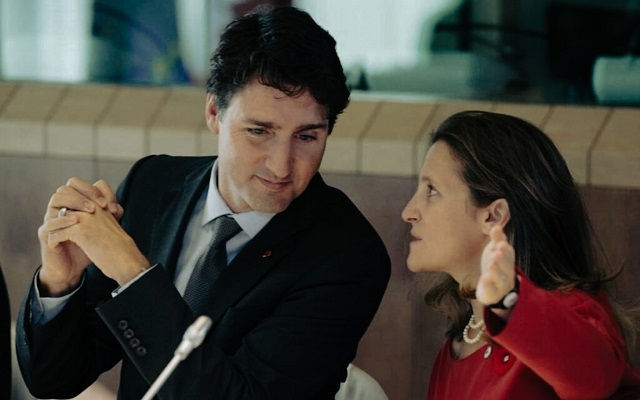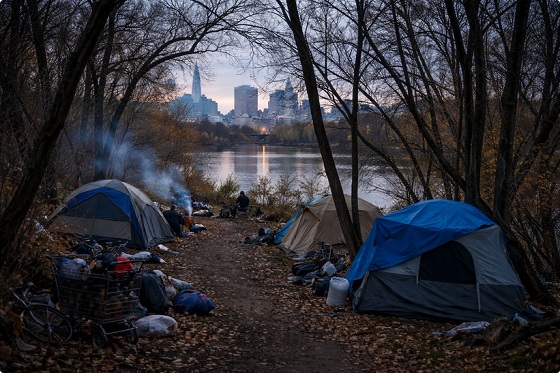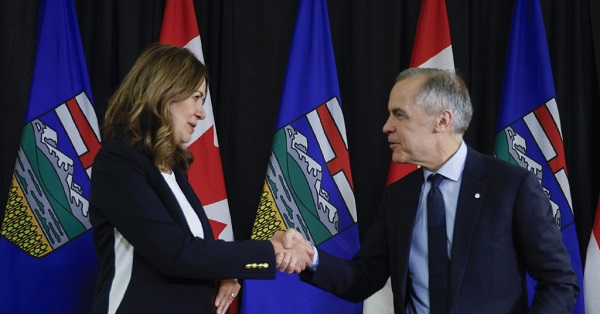National
Unemployment Surges as Trudeau’s Policies Wreak Havoc on the Economy

From The Opposition News Network
By Dan Knight
Let’s get real, folks. You look around, and it doesn’t take a PhD in economics to know something is seriously wrong. Unemployment’s ticking up to 6.6%, and wages? They’re not even keeping pace with inflation. Canadians are working harder than ever, yet the cost of everything—from the food you put on the table to the roof over your head—is spiraling out of control. And who’s at the wheel of this runaway train? Justin Trudeau, that’s who.
Trudeau’s government has unleashed a storm of reckless policies that are driving inflation through the roof. And what’s their solution? They’ve forced the Bank of Canada into a corner, leaving them with no choice but to keep rates above 4% interest rates at 4.25%. The result? Ordinary Canadians are feeling the squeeze like never before, struggling just to make ends meet. This isn’t some fluke; it’s a direct consequence of Trudeau’s economic mismanagement.
But here’s the kicker. While Canadians are tightening their belts, Trudeau’s government is flooding the country with immigrants, artificially inflating the GDP so they can keep funding their ridiculous green energy fantasies. That’s right. Instead of focusing on real, sustainable economic growth, Trudeau is pushing the numbers with mass immigration to cover up the economic disaster he’s created.
Think about that. You’re paying more for your groceries, your gas, your mortgage—all because Trudeau wants to make his government look good on paper. But it’s you who’s footing the bill.
Housing Crisis? That’s On Trudeau
Why can’t you afford a house anymore? Why are young families, people who grew up in this country, completely locked out of the housing market? The answer is simple—*it’s Justin Trudeau’s fault*.
Let’s be clear. The Bank of Canada has openly admitted that the housing crisis is a result of excess demand. But here’s what they’re not shouting from the rooftops: *that demand isn’t homegrown*. Trudeau’s open-door immigration policy has flooded the market, pushing housing prices through the roof. He’s not bringing in record numbers of immigrants because it’s good for Canada; he’s doing it to boost GDP artificially. The problem? That so-called “growth” is driving Canadians out of their own housing market.
You’ve got ordinary Canadians, people who’ve worked their whole lives, now completely priced out of homeownership because Trudeau has cranked up demand with his immigration policies. And while he’s busy making his numbers look good, you’re the one left without a chance to buy a home.
And what’s the solution Trudeau offers? Higher interest rates. That’s right. The Bank of Canada has been forced to keep rates above 4% (4.25%) just to cool down the mess Trudeau created. So now, not only are you dealing with sky-high prices, but the higher interest rates mean if you do somehow scrape together enough to buy a house, you’re stuck with a mortgage you can’t afford.
This isn’t just incompetence. It’s a deliberate strategy by Trudeau to artificially inflate the economy through immigration, all while making life harder for the average Canadian. This is the Trudeau legacy: inflated numbers on paper, while regular Canadians suffer in reality.
The Reality of Trudeau’s Policies
Everything costs more under Trudeau—everything. From your grocery bill to your taxes, life has gotten more expensive. But let’s not pretend this is some random economic downturn. This is the result of deliberate policies designed to make Trudeau look like he’s growing the economy. In reality, he’s burning through taxpayer dollars, and making life harder for the people who are actually *keeping this country going*—you.
And here’s the worst part: it’s not going to get better. As long as Trudeau is in charge, you’re going to keep seeing rising costs, more immigration to mask the economic stagnation, and higher interest rates making it impossible for Canadians to get ahead.
It’s time to stop pretending this is some unavoidable consequence of global forces. This is Justin Trudeau’s Canada, and the reality is, you’re being priced out of your own country.
Why Everything Costs More
Here’s the ugly truth: under Trudeau, everything costs more—much more. Groceries? Skyrocketing. Taxes? You can barely keep track of how many you’re paying. Energy bills? Forget it. These price hikes aren’t a coincidence—they’re a direct result of Trudeau’s reckless economic policies. This isn’t an accident; it’s the result of a deliberate plan to reshape Canada’s economy into some kind of climate-change fantasyland, and you’re the one paying for it.
Trudeau’s inflation problem started with his wild spending. The government kept printing and spending money, and soon enough, we had 8.1% inflation. While they love to pat themselves on the back for bringing it down to 2.5%, the reality is prices aren’t coming down. Groceries are still unaffordable. You’re paying 15-20% more for the basics like meat, vegetables, and even milk. Your wallet hasn’t seen any relief, despite their so-called victory lap.
Now, let’s talk about energy. Trudeau’s green energy agenda is a black hole sucking up billions in taxpayer dollars. Billions spent on unproven clean tech projects, and yet, have you seen your energy bills drop? Of course not. They’ve gone up. The kicker is, while Trudeau spends your money on windmills and electric buses that no one can afford, your gas and heating bills have soared. You’re being told to tighten your belt, but the government is lighting taxpayer dollars on fire.
Oh, and don’t forget taxes. Every time you turn around, there’s a new tax or an increase to an existing one. Carbon taxes, fuel taxes—everything is designed to make life more expensive. You’re paying more at the pump because of Trudeau’s so-called climate policies. Every single tax increase hits the working-class Canadian, the family just trying to get by. Meanwhile, Justin and his globalist buddies are laughing all the way to their next climate summit in a private jet.
A Trump Factor to Watch
And if you think this is bad, just wait. If Donald Trump wins re-election, Trudeau’s green pipe dream might come crashing down. Trump has promised to roll back Biden’s climate change initiatives. No more wind farms, no more billions funneled into solar power plants that never seem to get built. If Trump dismantles these climate policies, Trudeau’s entire green energy house of cards falls apart. Canada is deeply tied to U.S. climate cooperation—without it, Trudeau is left holding an empty bag. And what happens then? *You* will pay the price again as the government scrambles to find another way to fund their utopian schemes.
But it’s not just Trudeau’s climate pipe dreams that Trump could affect. Trump has been crystal clear—he’s bringing back tariffs, and Canada’s already weak GDP will take another hit. With Trudeau’s economic mismanagement, we can’t afford to take another blow. If Trump slams down new tariffs on Canadian goods, we’re looking at fewer jobs, higher prices, and an even deeper recession. Trudeau has left Canada exposed, and we’re the ones who will suffer for it.
Trudeau’s Legacy: Pain for the Average Canadian
Let’s face it—Trudeau’s legacy is one of pain for the average Canadian. He’s bloated the government, jacked up immigration numbers to artificially inflate GDP, and used that growth to justify even more spending. But who’s benefiting? Not you. Wages are stagnant, while the cost of living has gone through the roof. Why? Because the demand for everything from housing to groceries is being driven by immigration policies that Trudeau is using to fund his agenda. This isn’t about building a better Canada; it’s about maintaining the illusion of growth by bringing in more people to mask his economic failures.
Why can’t you buy a house? Because Trudeau’s open-door immigration policy has created an artificial demand for housing that has nothing to do with Canadians. The Bank of Canada has admitted it—excess demand is driving up housing costs. But here’s the kicker: this demand isn’t from Canadians trying to buy their first home. It’s from a government that’s using immigration as a crutch for economic growth that doesn’t actually exist. Meanwhile, you, the hard-working Canadian, are priced out of the market. You’re paying more, and Trudeau doesn’t care.
From taxes to groceries to housing, everything costs more under Justin Trudeau. And it’s all part of a grand scheme to push his climate agenda while using *your* hard-earned money to do it. So the next time you see your grocery bill or try to pay your heating bill, remember: this is the Canada Justin Trudeau built. How much longer can Canadians endure this? How much more can you take?

Please subscribe to The Opposition with Dan Knight .
For the full experience, upgrade your subscription.
Frontier Centre for Public Policy
Tent Cities Were Rare Five Years Ago. Now They’re Everywhere

From the Frontier Centre for Public Policy
Canada’s homelessness crisis has intensified dramatically, with about 60,000 people homeless this Christmas and chronic homelessness becoming entrenched as shelters overflow and encampments spread. Policy failures in immigration, housing, monetary policy, shelters, harm reduction, and Indigenous governance have driven the crisis. Only reversing these policies can meaningfully address it.
Encampments that were meant to be temporary have become a permanent feature in our communities
As Canadians settle in for the holiday season, 60,000 people across this country will spend Christmas night in a tent, a doorway, or a shelter bed intended to be temporary. Some will have been there for months, perhaps years. The number has quadrupled in six years.
In October 2024, enumerators in 74 Canadian communities conducted the most comprehensive count of homelessness this country has attempted. They found 17,088 people sleeping without shelter on a single autumn night, and 4,982 of them living in encampments. The count excluded Quebec entirely. The real number is certainly higher.
In Ontario alone, homelessness increased 51 per cent between 2016 and 2024. Chronic homelessness has tripled. For the first time, more than half of all homelessness in that province is chronic. People are no longer moving through the system. They are becoming permanent fixtures within it.
Toronto’s homeless population more than doubled between April 2021 and October 2024, from 7,300 to 15,418. Tents now appear in places that were never seen a decade ago. The city has 9,594 people using its shelter system on any given night, yet 158 are turned away each evening because no beds are available.
Calgary recorded 436 homeless deaths in 2023, nearly double the previous year. The Ontario report projects that without significant policy changes, between 165,000 and 294,000 people could experience homelessness annually in that province alone by 2035.
The federal government announced in September 2024 that it would allocate $250 million over two years to address encampments. Ontario received $88 million for ten municipalities. The Association of Municipalities of Ontario calculated that ending chronic homelessness in their province would require $11 billion over ten years. The federal contribution represents less than one per cent of what is needed.
Yet the same federal government found $50 billion for automotive subsidies and battery plants. They borrow tonnes of money to help foreign car manufacturers with EVs, while tens of thousands are homeless. But money alone does not solve problems. Pouring billions into a bureaucratic system that has failed spectacularly without addressing the policies that created the crisis would be useless.
Five years ago, tent cities were virtually unknown in most Canadian communities. Recent policy choices fuelled it, and different choices can help unmake it.
Start with immigration policy. The federal government increased annual targets to over 500,000 without ensuring housing capacity existed. Between 2021 and 2024, refugees and asylum seekers experiencing chronic homelessness increased by 475 per cent. These are people invited to Canada under federal policy, then abandoned to municipal shelter systems already at capacity.
Then there is monetary policy. Pandemic spending drove inflation, which made housing unaffordable. Housing supply remains constrained by policy. Development charges, zoning restrictions, and approval processes spanning years prevent construction at the required scale. Municipal governments layer fees onto new developments, making projects uneconomical.
Shelter policy itself has become counterproductive. The average shelter stay increased from 39 days in 2015 to 56 days in 2022. There are no time limits, no requirements, no expectations. Meanwhile, restrictive rules around curfews, visitors, and pets drive 85 per cent of homeless people to avoid shelters entirely, preferring tents to institutional control.
The expansion of harm reduction programs has substituted enabling for treatment. Safe supply initiatives provide drugs to addicts without requiring participation in recovery programs. Sixty-one per cent cite substance use issues, yet the policy response is to make drug use safer rather than to make sobriety achievable. Treatment programs with accountability would serve dignity far better than an endless supply of free drugs.
Indigenous people account for 44.6 per cent of those experiencing chronic homelessness in Northern Ontario despite comprising less than three per cent of the general population. This overrepresentation is exacerbated by policies that fail to recognize Indigenous governance and self-determination as essential. Billions allocated to Indigenous communities are never scrutinized.
The question Canadians might ask this winter is whether charity can substitute for competent policy. The answer is empirically clear: it cannot. What is required before any meaningful solutions is a reversal of the policies that broke it.
Marco Navarro-Genie is vice-president of research at the Frontier Centre for Public Policy and co-author with Barry Cooper of Canada’s COVID: The Story of a Pandemic Moral Panic (2023).
Fraser Institute
How to talk about housing at the holiday dinner table

From the Fraser Institute
The holidays are a time when families reconnect and share cherished traditions, hearty meals and, occasionally, heated debates. This year, housing policy might be a touchy subject at the holiday dinner table. Homebuilding has not kept pace with housing demand in Canada, causing a sharp decline in affordability. Efforts to accelerate homebuilding are also changing neighbourhoods, sometimes in ways that concern residents. Add in a generational divide in how Canadians have experienced the housing market, and it’s easy to see how friends and family can end up talking past one another on housing issues.
Some disagreement about housing policy is inevitable. But in the spirit of the holidays, we can keep the conversation charitable and productive by grounding it in shared facts, respecting one another’s housing choices, and acknowledging the trade-offs of neighbourhood change.
One way to avoid needless conflict is to start with a shared factual baseline about just how unaffordable housing is today—and how that compares to the past.
The reality is that today’s housing affordability challenges are severe, but not entirely unprecedented. Over the past decade, prices for typical homes have grown faster than ordinary families’ after-tax incomes in nearly every major city. At the pandemic-era peak, the mortgage burden for a typical purchase was the worst since the early 1980s. The housing market has cooled in some cities since then, but not enough to bring affordability back to pre-pandemic levels—when affordability was already strained.
These facts provide some useful context for the holiday dinner table. Today’s aspiring homebuyers aren’t wrong to notice how hard it has become to enter the market, and earlier generations aren’t exaggerating when they recall the shock of double-digit interest rates. Housing affordability crises have happened in the past, but they are not the norm. Living through a housing crisis is not, and should not be, a generational rite of passage. Canada has had long periods of relative housing affordability—that’s what we should all want to work towards.
Even when we agree on the facts about affordability, conflicts can flare up when we judge one another’s housing choices. Casual remarks like “Who would want to live in a shoebox like that?” or “Why would anyone pay that much for so little?” or “Why are you still renting at your age?” may be well-intentioned but they ignore the constraints and trade-offs that shape where and how people live.
A small townhome with no yard might seem unappealing to someone who already owns a single-detached house, but for a first-time homebuyer who prioritizes living closer to work or childcare, it might be the best option they can afford.
At first glance, a new condo or townhome might look “overpriced” compared with nearby older single-family homes that offer more space. But buyers must budget for the full cost of ownership, including heating bills, maintenance and renovations, which can make the financial math on some “overpriced” new homes pencil out.
And renting isn’t necessarily a sign that someone is falling behind. Many renters are intentionally keeping their options open: to pursue job opportunities in other cities, to sort out their romantic lives before committing to homeownership, or to invest their money outside of real estate.
This isn’t just a dinner-table issue. The belief that “no one wants to live like that” leads some to support policies restricting apartments, townhomes or purpose-built rentals on the premise that they’re inherently undesirable. A better approach is to set fair rules and let builders respond to what Canadian families choose for themselves—not what we think they should want.
The hardest housing conversations are about where new homes should go, and who gets a say as neighbourhoods change.
It’s natural for homeowners to feel uneasy about how their neighbourhoods might change as a consequence of housing redevelopment. But aspiring homebuyers are also right to be frustrated when local restrictions prevent the kinds of homes Canadian families want from being built in the places they want to live. The economics is clear—allowing more housing styles to be built in more places means greater options and lower prices for renters and homebuyers.
There’s no simple way to balance the competing views of existing residents and aspiring homebuyers. But the conversation becomes more productive if both sides recognize an unavoidable trade-off—resistance to neighbourhood change reliably restricts housing options and makes housing less affordable, but redevelopment can entail real downsides for existing residents.
Everyone wants better housing outcomes for Canadian families, but we won’t get them by talking past one another. If we bring empathy to the table and stay clear eyed about the trade-offs, we’ll collectively make better housing policy decisions—and have calmer holiday dinners.
-

 Energy1 day ago
Energy1 day agoThe Top News Stories That Shaped Canadian Energy in 2025 and Will Continue to Shape Canadian Energy in 2026
-

 Business2 days ago
Business2 days agoSome Of The Wackiest Things Featured In Rand Paul’s New Report Alleging $1,639,135,969,608 In Gov’t Waste
-

 International1 day ago
International1 day ago$2.6 million raised for man who wrestled shotgun from Bondi Beach terrorist
-

 Alberta1 day ago
Alberta1 day agoOttawa-Alberta agreement may produce oligopoly in the oilsands
-

 Frontier Centre for Public Policy10 hours ago
Frontier Centre for Public Policy10 hours agoTent Cities Were Rare Five Years Ago. Now They’re Everywhere
-

 Energy2 days ago
Energy2 days ago‘The electric story is over’
-

 Energy1 day ago
Energy1 day agoWestern Canada’s supply chain for Santa Claus
-

 Opinion11 hours ago
Opinion11 hours agoPope Leo XIV’s Christmas night homily





